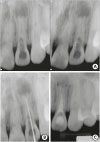1. Alani A, Bishop K. Dens invaginatus. Part 1: classification, prevalence and aetiology. Int Endod J. 2008; 41:1123–1136.

2. Oehlers FA. Dens invaginatus (dilated composite odontome). I. Variations of the invagination process and associated anterior crown forms. Oral Surg Oral Med Oral Pathol. 1957; 10:1204–1218.
3. Bäckman B, Wahlin YB. Variations in number and morphology of permanent teeth in 7-year-old Swedish children. Int J Paediatr Dent. 2001; 11:11–17.

4. Casamassimo PS, Nowak AJ, Ettinger RL, Schlenker DJ. An unusual triad: microdontia, taurodontia, and dens invaginatus. Oral Surg Oral Med Oral Pathol. 1978; 45:107–112.

5. Ekman-Westborg B, Julin P. Multiple anomalies in dental morphology: macrodontia, multituberculism, central cusps, and pulp invaginations. Report of a case. Oral Surg Oral Med Oral Pathol. 1974; 38:217–222.

6. Ruprecht A, Batniji S, Sastry KA, el-Neweihi E. The incidence of dental invagination. J Pedod. 1986; 10:265–272.
7. Siraci E, Gungor HC, Cehreli ZC. Dens invaginatus and talon cusp co-occurring in a mandibular central incisor: a case report. J Dent Child (Chic). 2008; 75:177–180.
8. Nagaveni NB, Umashanikara KV, Vidyullatha BG, Sreedevi S, Radhika NB. Permanent mandibular incisor with multiple anomalies - report of a rare clinical case. Braz Dent J. 2011; 22:346–350.

9. Anthonappa RP, Yiu CK, King NM. A novel combination of dens evaginatus and dens invaginatus in a single tooth--review of the literature and a case report. J Clin Pediatr Dent. 2008; 32:239–242.

10. Kerebel B, Kerebel LM, Daculsi G, Doury J. Dentinogenesis imperfecta with dens in dente. Oral Surg Oral Med Oral Pathol. 1983; 55:279–285.

11. Subramaniam A, Kamtane S, Desai R, Thakre G. Dens in dente of maxillary third molar. J Oral Maxillofac Pathol. 2008; 12:88–89.

12. Knezević G. Dens invaginatus with ameloblastoma. Oral Surg Oral Med Oral Pathol. 1980; 49:274.

13. Conklin WW. Bilateral dens invaginatus in the mandibular incisor region. Oral Surg Oral Med Oral Pathol. 1978; 45:905–908.

14. Hülsmann M. Dens invaginatus: aetiology, classification, prevalence, diagnosis, and treatment considerations. Int Endod J. 1997; 30:79–90.

15. Capar ID, Ertas H, Arslan H, Tarim Ertas E. A retrospective comparative study of cone-beam computed tomography versus rendered panoramic images in identifying the presence, types, and characteristics of dens invaginatus in a Turkish population. J Endod. 2015; 41:473–478.

16. Gangwar A, Singal D, Giri KY, Agarwal A, Keerthi SS. An immature type II dens invaginatus in a mandibular lateral incisor with Talon's cusp: a clinical dilemma to confront. Case Rep Dent. 2014; 2014:826294.

17. Er K, Kuştarci A, Özan U, Taşdemir T. Nonsurgical endodontic treatment of dens invaginatus in a mandibular premolar with large periradicular lesion: a case report. J Endod. 2007; 33:322–324.

18. Cho WC, Kim MS, Lee HS, Choi SC, Nam OH. Pulp revascularization of a severely malformed immature maxillary canine. J Oral Sci. 2016; 58:295–298.

19. Afkar M, Gholamshahi M, Mohammadi M. Nonsurgical treatment of type II dens invaginatus in a maxillary lateral incisor using cone-beam computed tomography. Iran Endod J. 2018; 13:132–134.
20. Zhang P, Wei X. Combined therapy for a rare case of type III dens invaginatus in a mandibular central incisor with a periapical lesion: a case report. J Endod. 2017; 43:1378–1382.

21. Brooks JK, Ribera MJ. Successful nonsurgical endodontic outcome of a severely affected permanent maxillary canine with dens invaginatus Oehlers type 3. J Endod. 2014; 40:1702–1707.

22. Schwartz SA, Schindler WG. Management of a maxillary canine with dens invaginatus and a vital pulp. J Endod. 1996; 22:493–496.

23. Vier-Pelisser FV, Morgental RD, Fritscher G, Ghisi AC, Borba MG, Scarparo RK. Management of type III dens invaginatus in a mandibular premolar: a case report. Braz Dent J. 2014; 25:73–78.

24. Canger EM, Kayipmaz S, Çelenk P. Bilateral dens invaginatus in the mandibular premolar region. Indian J Dent Res. 2009; 20:238–240.

25. Gallacher A, Ali R, Bhakta S. Dens invaginatus: diagnosis and management strategies. Br Dent J. 2016; 221:383–387.

26. Shadmehr E, Farhad AR. Clinical management of dens invaginatus type 3: a case report. Iran Endod J. 2011; 6:129–132.
27. Gupta R, Tewari S. Nonsurgical management of two unusual cases of dens in dente. J Indian Soc Pedod Prev Dent. 2005; 23:190–192.

28. Agrawal PK, Wankhade J, Warhadpande M. A rare case of type III dens invaginatus in a mandibular second premolar and its nonsurgical endodontic management by using cone-beam computed tomography: a case report. J Endod. 2016; 42:669–672.

29. Teixidó M, Abella F, Duran-Sindreu F, Moscoso S, Roig M. The use of cone-beam computed tomography in the preservation of pulp vitality in a maxillary canine with type 3 dens invaginatus and an associated periradicular lesion. J Endod. 2014; 40:1501–1504.

30. Kharangate N, Figueiredo NR, Fernandes M, Lambor R. Bilateral dens invaginatus in the mandibular premolars - Diagnosis and treatment. Contemp Clin Dent. 2015; 6:428–431.

31. Vincent-Townend J. Dens invaginatus. J Dent. 1974; 2:234–238.

32. Teplitsky P, Singer D. Radicular anomaly of a maxillary canine; endodontic treatment. J Endod. 1987; 13:81–84.

33. Olmez S, Uzamis M, Er N. Dens invaginatus of a mandibular central incisor: surgical endodontic treatment. J Clin Pediatr Dent. 1995; 20:53–56.
34. Chaniotis AM, Tzanetakis GN, Kontakiotis EG, Tosios KI. Combined endodontic and surgical management of a mandibular lateral incisor with a rare type of dens invaginatus. J Endod. 2008; 34:1255–1260.








 PDF
PDF Citation
Citation Print
Print





 XML Download
XML Download